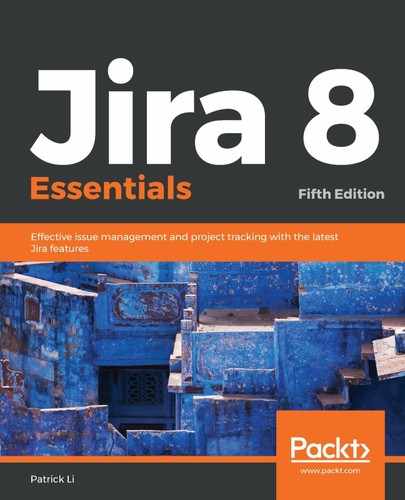As we have already discussed, an issue in Jira can be anything in the real world to represent a unit of work or a task to be completed. In this section, we will look at how Jira presents an issue in the user interface for Jira Core and Jira Software. We will cover Jira Service Desk in Chapter 11, Jira Service Desk, as it has a different interface.
First, let's take a look at an issue in Jira Core. The following screenshot shows a typical example of an issue and breaks it down into more digestible sections, followed by an explanation of each of the highlighted sections in a table. This view is often called the issue summary or the View Issue page:

These sections are described in the following table:
| Section | Description |
| project/issue key | This shows the project the issue belongs to. The issue key is the unique identifier of the current issue. This section acts as a breadcrumb for easy navigation. |
| issue summary | This is a brief summary of the issue. |
| issue export options | These are the various view options for the issue. The options include XML, Word, and Printable. |
| issue operations | These are the operations that users can perform on the issue, such as edit, assign, and comment. These are covered in later sections of this chapter. |
| workflow options | These are the workflow transitions that are available. Workflows will be covered in Chapter 7, Workflows and Business Process. |
| issue details /fields | This section lists the issue fields, such as issue type and priority. Custom fields are also displayed in this section. Fields will be covered in Chapter 5, Field Management. |
| user fields | This section is specific for user-type fields, such as assignee and reporter. Fields will be covered in Chapter 5, Field Management. |
| date fields | This section is specific for date-type fields, such as create and due date. Fields will be covered in Chapter 5, Field Management. |
| attachments | This lists all the attachments in an issue. |
| sub-tasks | Issues can be broken down into smaller subtasks. If an issue has subtasks, they will be listed in this section. |
| comments | This lists all the comments that are visible to the current user. |
| work log | This lists all the time-tracking information your users have logged against the issue. See the Time tracking section for more details. |
| history | Keeps track of all changes that have occurred for this issue, including the values that are used before and after the change. |
| activity | This is similar to history, but is formatted in a more user-friendly way. It can also generate an RSS feed for the content. |
Jira Software, when running Scrum or Kanban, uses the agile board user interface, which represents issues as cards on a board, as described in Chapter 3, Using Jira for Agile Projects, which has a more concise summary of issues. However, when you click on the card, Jira will expand and display the detailed information of the issue, as shown in the preceding table.
